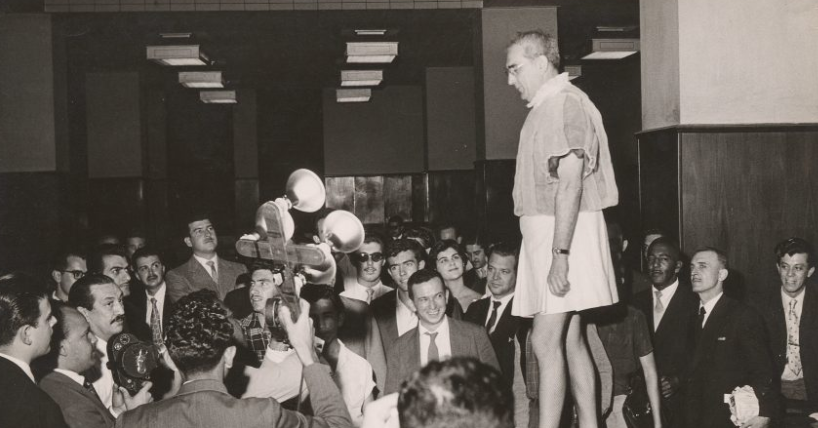
Celebrating a Visionary on World Architecture Day
On 6 October 2025, architects, students, and enthusiasts worldwide observe World Architecture Day, a global event that highlights the transformative power of design. Newcastle University takes this opportunity to honor an alumnus whose work bridged engineering, fine art, and performance: Flavio de Carvalho. By revisiting Carvalho’s legacy, we gain insight into the early roots of modernist architecture in Brazil and the enduring impact of multidisciplinary practice on contemporary design education.
Early Life and Education
Flavio de Carvalho was born in 1899 into an affluent family in Brazil. His formative years were steeped in the cultural dynamism of early 20th‑century Paris, where he absorbed both the rigor of civil engineering and the expressive freedom of fine art. In 1919, following the end of World War I, Carvalho enrolled at Armstrong College—now the School of Engineering at Newcastle University—seeking a structured foundation in structural design.
Armstrong College was a unique environment. After the war, the campus had served as the 1st Northern General Hospital, treating more than 40,000 servicemen. By the time Carvalho arrived, the institution was transitioning back to academia, reintroducing degrees in civil engineering and, five years later, in fine art. His dual studies positioned him at the intersection of technical precision and creative exploration, a combination that would characterize his later projects.
Architectural Innovation in Brazil
Carvalho’s return to Brazil marked a swift shift from engineering to speculative design and creative practice. In 1928 he submitted a bold proposal for a Governor’s Palace in São Paulo, blending militaristic style with the emerging modernist vocabulary. Although the project did not materialise, the concept reflected a forward‑looking vision that would later influence regional planning projects.
Throughout the 1930s and 1940s, Carvalho presented several ambitious architectural plans—most notably the proposals for the São Paulo Town Hall (1939, revisited 1946 and 1952) and the International University of Music (1955). His designs consistently challenged conventional aesthetics, integrating local cultural references with avant‑garde structural concepts. One of his most physically realized works was a modernist residential complex, comprising 17 independent houses on Alameda Lorena in Jardim Paulista. The estate, along with his own Fazenda Capuava in Valinhos, showcased a synthesis of pre‑Incan geometric symbolism and the monumental form of a mastaba, a shape traditionally associated with Egyptian tombs.
The Fusion of Art and Architecture
Carvalho’s architectural pursuits were inseparable from his work as a painter and performance artist. Influenced by the writings of Sigmund Freud and anthropologist James Frazer, he explored the psychological and social dimensions of space. His 1947 charcoal drawings on the death of his mother illustrate a capacity to translate personal experience into visceral visual narratives—a technique that resonated in his architectural compositions.
His participation in the 1950 Venice Biennale positioned him on an international platform, allowing him to exchange ideas with leading artists of the time. The following year, his paintings featured in the Royal Academy’s “Brasil! Brasil! The Birth of Modernism” exhibition, cementing his status as a pioneer who bridged Brazilian artistic traditions with contemporary European trends.
Legacy and Influence Today
While many of Carvalho’s architectural projects remained on paper, his influence persisted through the multidisciplinary approach he championed. The Clube dos Artistas Modernos (CAM) he co‑founded in 1932 served as a cultural hub—hosting live drawings, lectures on folklore and politics, and performances spanning samba, tango, Afro‑Brazilian macumba, Russian ballet, and classical chamber music. By fostering cross‑class and cross‑race dialogue, CAM became a focal point for avant‑garde ideas, albeit drawing the notice of state authorities who monitored potentially subversive activities.
Carvalho’s experimental performances—such as his 1931 “experiência” that challenged the Catholic Corpus Christi parade, and his 1956 “Traje de Verão” walking in São Paulo—demonstrated a keen interest in crowd psychology and societal norms. These acts prefigured contemporary practice in performance art and architectural installations, offering a provocative lens through which to confront cultural conventions.
Connecting with Newcastle University’s Architecture School
Newcastle University’s School of Architecture, founded from the Northern Architectural Association, prides itself on a legacy that includes modernist luminaries such as Alison and Peter Smithson, Terry Farrell, and the Matrix feminist architects collective. The school’s curriculum encourages interdisciplinary collaboration, mirroring Carvalho’s own career path that spanned engineering, fine art, and performance. Students are encouraged to experiment with materiality and societal engagement—core principles illustrated by Carvalho’s work.
Alumni of the School of Architecture regularly engage in global architectural conferences, contributing to discourses on sustainability, digital fabrication, and social impact. The influence of alumni like Carvalho underscores the value of embracing both technical expertise and creative exploration in designing built environments that respond to human experience.
Take Action – Explore Opportunities at Newcastle University
Whether you are a prospective student, a professional seeking further study, or an alumnus wishing to reconnect, Newcastle University offers a range of programs and events that can help you grow. Visit the School of Architecture, Planning and Landscape website to discover degree offerings and research groups. Apply today and join a community that celebrates innovation as it did in the era of Flavio de Carvalho.
Schedule a free consultation with our admissions team to discuss how Newcastle’s multidisciplinary approach can align with your career goals. Contact us for personalized guidance.
Have questions? Write to us and we’ll help you navigate the next steps.
Share your experiences or reflections on modernist architecture in the comments below—your insights contribute to an ongoing conversation that echoes across generations.
Explore our related articles for deeper dives into architectural history, sustainability practices, and alumni achievements.

